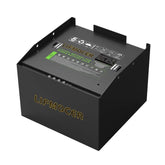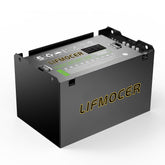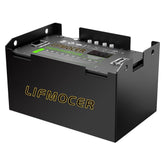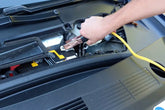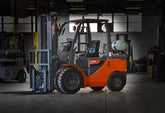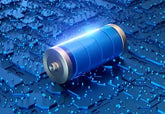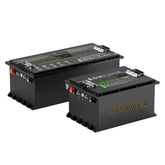Can You Jump Start a Car In The Rain?
Why Drivers Worry About Jump Starting in Wet Weather
When your car battery suddenly dies in the rain, many people's first reaction is: 'can I jump start a car in the rain? Will I get electrocuted?' When encountering such a situation, many drivers will have such concerns. They often worry that jumping the car in the rain may cause electric shock, short circuit, or even damage the vehicle's electrical system.
Online discussions on Reddit and Quora reveal the same worries — some drivers insist it’s too risky, while others say they’ve done it countless times without any issues. This mix of fear and uncertainty stems from misunderstanding how car batteries actually work in wet conditions. So, why do these concerns persist? It all comes down to a lack of clarity about the voltage, insulation, and real safety risks involved — Let's dispel these misconceptions and explain what you need to know to safely jump-start your car in the rain.

Is It Safe to Jump Start a Car in Rain?
It may sound dangerous to mix water and electricity, but jump-starting a car in the rain is actually safe when done properly. Most vehicles today have well-insulated electrical systems that can handle normal exposure to rain without causing shocks or serious faults. The 12-volt current from a car battery or portable jump starter is too low to harm a person under typical conditions, so the fear of being electrocuted is largely a misunderstanding.
What truly matters is the way you perform the jump. Problems usually occur when clamps are not attached correctly or when metal contacts are wet and exposed. If water seeps into the connectors, it can cause a brief spark or corrosion over time. As long as the car jump starter cables are in good condition and connections are firm, jump-starting in rainy weather won’t damage the car or create safety hazards.
What Happens If Rain Gets on the Battery or Cables
Many drivers worry that a few raindrops on their battery or jump starter cables could cause serious problems. Fortunately, light rain or moisture rarely poses a danger. Modern car batteries are housed in plastic cases designed to resist water, and the jumper cables are insulated to prevent short circuits under normal conditions.
Real-world experiences from Reddit users confirm this. One user shared:
“It was raining, and the battery had water droplets on it. I wiped it off and jump started the car — no sparks, no issues at all.”
Comments across forums consistently point out that minor moisture on the battery surface is not catastrophic. Plain rainwater is a poor conductor, and the 12-volt system simply doesn’t have enough power to create a dangerous shock.
The real concern arises when water creates a conductive path between the positive and negative terminals or if the cable insulation is damaged. In those cases(next paragragh), a short circuit could occur, producing sparks or even minor corrosion over time. That’s why it’s a good practice to wipe off any excessive moisture from the terminals and ensure that clamps stay dry and secure while connecting. Autozone also suggested in Can You Jump a Car in the Rain that by keeping terminals dry and using intact jumper cables, you can confidently jump start your car even in wet conditions.

Potential Risks of Jump Starting in Rain
While jump starting a car in the rain is generally safe when done properly, there are still some potential risks that drivers should be aware of:
- Water bridging the battery terminals. Heavy rain or puddles can create a conductive path between the positive and negative terminals, potentially causing sparks or short circuits. This is more likely if the battery is non-sealed or damaged.
- Slippery surfaces. Standing on wet pavement or mud increases the risk of slipping while handling jumper cables. A sudden fall while holding metal clamps could cause minor injuries or accidental shorting of the battery.
- Damaged or frayed cables. Exposed wires combined with moisture can create sparks, reduce efficiency, and even damage the vehicle’s electrical system. Always inspect cables before use.
- Extreme weather hazards. Lightning storms, flooding, or torrential rain introduce additional risks that go beyond simple battery concerns. In such cases, it’s safer to wait for better conditions or call professional roadside assistance.
- Battery leakage or explosion (rare). Though extremely uncommon, a severely damaged or overcharged battery may leak acid or produce flammable gases. Wet conditions alone do not trigger this, but sparks from improper connections could ignite these gases.

How to Jump Start a Car Safely in the Rain
To help you get back on the road safely, we’ll cover two methods that drivers commonly use: the traditional jump starter cable method and the modern lithium jump starter method. Choose whichever suits your situation best.
Method 1: Using Jumper Cables
If another vehicle is available, jumper cables can help bring your car back to life. However, wet conditions require extra care. Here’s how to do it safely:
- Park both cars safely. Make sure both vehicles are on stable, non-flooded ground with parking brakes engaged. Turn off both engines and keep the keys out of the ignition.
- Inspect the cables. Ensure your jumper cables are completely dry and undamaged. Avoid using cables with exposed wires or corrosion on the clamps.
- Connect the red clamps. Attach one red clamp to the positive (+) terminal of the dead battery and the other red clamp to the positive terminal of the working vehicle’s battery.
- Connect the black clamps. Attach one black clamp to the negative (–) terminal of the working battery. Attach the other black clamp to an unpainted metal part of the dead car’s engine block, not the battery terminal.
- Start the working vehicle first. Let it run for a minute or two to transfer power. Then, try starting the dead car.
- Remove the cables carefully. Once the dead car starts, disconnect the cables in reverse order and avoid letting the clamps touch each other or any wet surface.
Method 2: Using a Lithium Jump Starter
If you don’t have another vehicle nearby, a lithium jump starter (portable car emergency power supply) is a convenient and safer choice — especially in wet conditions. Follow these steps:
- Check your surroundings. Move your vehicle to a safe area if possible, avoiding deep puddles or direct rain on the battery.
- Keep everything dry. Wipe off rainwater from the battery terminals and jump starter clamps before connecting.
- Connect the clamps. Attach the red clamp to the positive (+) terminal and the black clamp to the negative (–) terminal of your car battery.
- Power on the power device. Turn on the car jump starter and wait for the indicator to confirm it’s ready.
- Start your engine. Try starting the vehicle. Once it runs, turn off the jump starter and remove the clamps in reverse order.
- Store the device properly. Dry off the jump start battery and store it in a waterproof case or glove box for future use.
Both methods can work effectively in rainy weather, but the lithium jump starter offers an extra layer of safety and convenience. It doesn’t rely on another vehicle and is designed with protection features such as spark prevention and short-circuit safeguards — making it the preferred choice for many modern drivers.
What to Do If Startup Fails
Even after following all the right steps, sometimes a car just won’t start — especially in wet weather. When jump-starting fails, it’s important not to panic. There are a few logical reasons why it might happen, and several safe steps you can take next.
First, check the obvious: are the jumper cables or jump starter clamps firmly connected to clean metal surfaces? Loose or corroded terminals are one of the most common causes of failed jump starts. Wipe away moisture or dirt and make sure both red and black clamps are secure. If you’re using a portable car jump starter, ensure it’s fully charged and compatible with your vehicle’s engine capacity.
If the car starts but dies again shortly afterward, that’s often a sign the issue runs deeper than the battery. A weak alternator may not be recharging the battery, or the battery’s internal cells may be severely degraded. In this case, continuing to jump-start won’t help — you’ll need professional inspection or a replacement battery. As AutoZone’s battery guide explains, a battery that repeatedly drains soon after charging is typically beyond recovery and should be replaced.
Weather also matters. If it’s storming with lightning, strong winds, or standing water around the car, it’s safest to wait until conditions improve before attempting another start. Thunderstorms add risks of electrical surges and slippery conditions that make handling cables unsafe. According to Can You Jump a Car in the Rain of CarParts.com , jump-starting should never be done during an active lightning storm — the risk of shock or equipment damage outweighs the benefit.
Finally, know when to call for help. If you’ve double-checked connections, tried a second power source, and the vehicle still won’t respond, the issue may be with the alternator, starter motor, or internal wiring. In that case, contact roadside assistance or a certified mechanic. They have the diagnostic tools to locate the fault and prevent further damage to the vehicle’s electrical system.
Common Mistakes to Avoid When Jump Starting in the Rain
To make jump starting in the rain even safer and more efficient, consider the following expert tips:
- Always check jumper cables for damage or loose insulation; exposed copper wire is particularly dangerous in the rain, easily causing sparks or short circuits.
- Use safety gear such as goggles and waterproof gloves. Any jumpering, not just in the rain, can cause eye or skin damage from battery gas release or tiny sparks during wiring.
- Before connecting, ensure the jumper is fully charged and all cables and clamps are secure and properly mated (positive to positive, negative/grounded). This is crucial for a high jump start success rate.
- During the jumpering process, minimize direct rain from falling on the battery terminals or clamps. Use an umbrella, tarpaulin, engine hood, etc. to protect the connection points and avoid direct water flow.
- If you're operating in extremely inclement weather (strong winds, heavy rain, lightning) or when the ground is slippery and unstable, it's best to wait for the weather to improve or move to a safer, drier area before proceeding.
Expert Tips for Safe and Quick Jump Starts
Even though jump-starting in the rain is generally safe, following expert advice can make the process faster and more reliable. Automotive specialists from CarParts.com advise: Always inspect jumper cables for damage or loose insulation; exposed copper wire is especially dangerous in the rain and can easily cause sparks or short circuits.
Experts from AutoZone also emphasize using safety gear such as goggles and waterproof gloves. Any jumpering, not just in the rain, can cause eye or skin damage from battery gas release or tiny sparks during wiring.
In rainy conditions, it’s best to use the hood or a waterproof cover to shield the battery and cables from direct rain. Keep the connection points dry, and if weather conditions are extreme—such as heavy storms or standing water—wait until it’s safer to proceed. These expert-backed tips help you stay protected while restoring power to your car efficiently, even in wet weather.
What to Do After Jump Starting in Rainy Conditions
Once your car successfully starts in the rain, don’t drive away immediately. Keep the engine running for at least 15 to 20 minutes to allow the alternator to recharge the battery. This helps restore the power that was lost and ensures your vehicle won’t stall again once you turn it off. During this time, check that all electrical systems—like the headlights, wipers, and defroster—are functioning properly.
If you used traditional jump start cables, carefully remove them in reverse order and make sure they don’t touch any wet metal surfaces. Wipe down any moisture on the battery terminals and cables with a dry cloth to prevent corrosion later. For those who used a portable jump starter, store it in a dry place and recharge it as soon as possible, so it’s ready for the next emergency.
It’s also worth taking a moment to inspect your battery after the rain. Look for cracks, leaks, or heavy corrosion, which can indicate the battery is nearing the end of its life. If your car has trouble starting again soon after the jump, it may be time to test or replace the battery. A quick follow-up check at an auto service center can help you avoid another inconvenient breakdown in the future.

What Drivers Say: Real Experiences from the Rain
Online discussions reveal that many drivers have faced the same situation—trying to jump start a dead car battery in the middle of the rain. On forums like Reddit and Quora, drivers share mixed experiences. Some admit they were nervous at first, fearing the combination of water and electricity, but later found that nothing dangerous happened when they followed the proper steps. Many users mentioned using umbrellas or keeping the hood partly closed to protect the cables from getting soaked.
Others pointed out that car batteries are well-insulated and designed to handle occasional moisture. A few mechanics in the same threads confirmed that as long as the clamps are attached correctly and there’s no standing water on the terminals, jump-starting in light rain poses minimal risk. There were also stories from drivers who had to rely on a portable jump starter in stormy weather, praising its convenience since it avoids connecting two vehicles in wet conditions.
Conclusion: Jump Starting Safely, Even in the Rain
Jump-starting a car in the rain may sound intimidating, but as countless drivers and experts confirm, it’s completely safe when done with care and proper equipment. Modern vehicles are built with waterproof insulation, and the 12-volt system used in car batteries or lithium jump starters poses no real threat under normal conditions. What matters most is staying cautious—keeping clamps dry, avoiding damaged cables, and following the correct connection sequence.
Whether you rely on traditional car jump start cables or a portable vehicle jump starter, taking a few simple precautions ensures both your safety and your car’s health. Always inspect the battery afterward, recharge your jump start battery, and allow the alternator time to recover the lost power. As shared by real drivers on Reddit and Quora, a bit of rain doesn’t have to ruin your day — with the right knowledge, you can confidently get your vehicle started and back on the road, no matter the weather.

FAQ / People Also Ask
Is jump starting a car in the rain dangerous?
No, it’s not dangerous if you use proper equipment and follow safety steps. The car’s 12-volt system won’t electrocute you, but be careful of sparks and wet cables.
Can you jump start a car during a thunderstorm?
It’s better to wait until the storm passes. Lightning is unpredictable, and standing outside near metal objects can be risky.
Can water damage a car battery?
Rain alone won’t damage a sealed battery, but prolonged exposure to moisture can corrode the terminals or cause poor connections.
Can I use my portable jump starter in the rain?
Yes, but keep it dry and protected from direct rain. Some waterproof models can handle light splashes but should never be fully soaked.
Can Jump Starting a Car Drain Your Battery?
Not usually. If the donor car’s engine is running during the jump, its alternator keeps the battery charged, so the power loss is minimal. It only becomes an issue if you jump-start repeatedly with the engine off or if your own battery is already weak.


